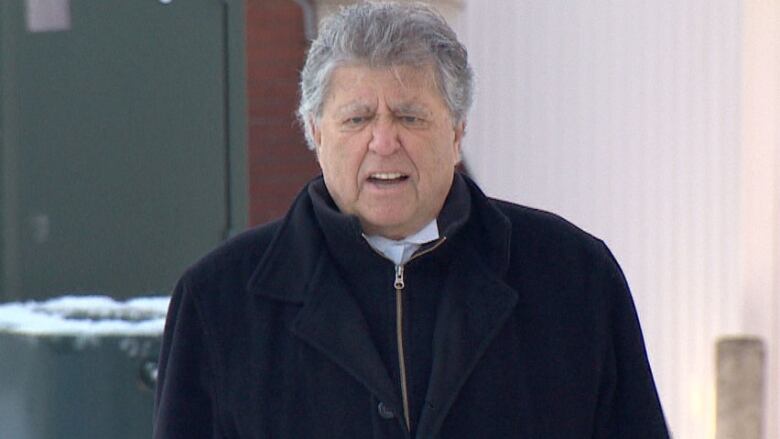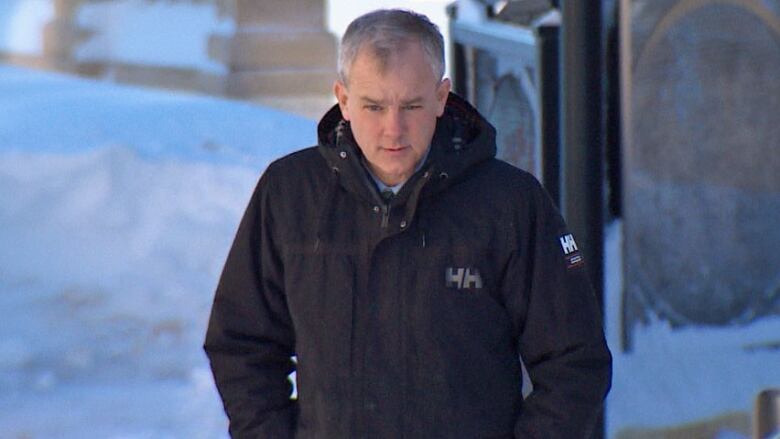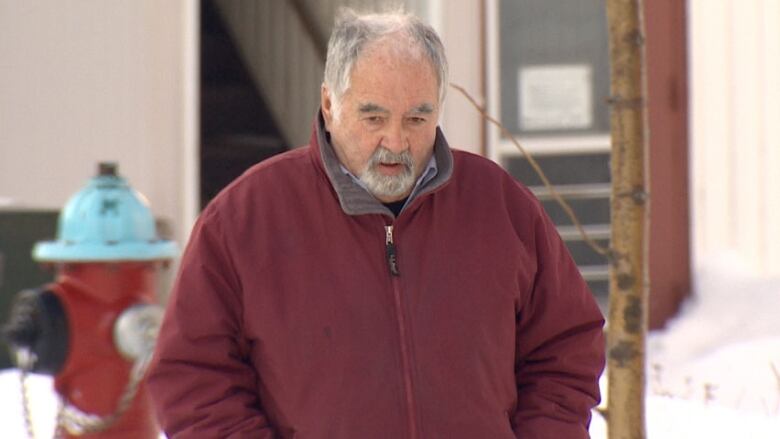Dennis Oland defence abruptly withdraws cellphone witness at murder retrial
Oland lawyer accuses Crown of trying to ambush defence with unknown line of questioning

DennisOland'sdefence team began presenting its case at his murder retrial Tuesday, but abruptly withdrew one of its witnesses before he provided any evidence, accusing the Crown of trying to ambush the defence.
Lead defence lawyer Alan Gold had planned to have Gregory Baumeister, a core network specialist with the telecommunications company Ericsson, testify about attempts by Saint John police and Rogers Communications to locate Richard Oland's missing cellphone.
The retrial has heard efforts to "ping" the phone came back with a "roaming error" message.
What that means or how it's significant to the defence has not yet been revealed, but Gold has said the defence misunderstood some of the cellphone-related evidence at Dennis Oland'sfirst trial in the 2011 bludgeoning death of his father.
"We were misinformed" in 2015, Goldhas said. "We now understand 'roaming error' correctly."
Gold sought to haveBaumeister declared an expert able to give opinion evidence on the mobile positioning technologies Ericsson provides to Rogers and the meaningof messages generated by those technologies, including roaming errors.
Crown prosecutor Derek Weaver wanted the court tobroadenBaumeister's qualifications to include the design and operation of the Rogers network, noting he had worked for Rogers from 1989 to 1998, commissioning and maintaining cell towers.
Court of Queen's Bench Justice Terrence Morrison instructed the parties to settle the matter during the lunch break. But when court resumed, Gold argued the Crown had notprovidednotice of its intention to expand Baumeister's qualifications in order to advance its own case.

"As a simple tactical decision, how can we present a witness where the Crown apparently feels they're going to obtain favourable evidence of which we have no notice?" he asked.
The defence did not want to walk blindly into a unknown line of questioning by the Crown, he said.
"In the circumstances, the unfairness is such that the defence has no option but to withdraw the witness, and that's what we propose to do."
Weaver arguedBaumeisterwas not only a defence witness.
"Once an expert witness takes the stand, he or she is offering their professional opinion for the assistance of the court in pursuit of the truth."
Weaver took issue with Gold's characterization of the Crown's intentions. He said he simply planned to ask Baumeister which definition of roaming error would be most likely. "I don't see anything improper with that."
The judge noted it was "a moot point" if the defence was withdrawingBaumeister. Gold confirmedthey were.
Accused expected to testify Wednesday

Oland, 51, is being retried for second-degree murder afterthe New Brunswick Court of Appeal overturned his 2015 conviction, citing an error in the trial judge's instructions to the jury.
His retrial by judge alone began on Nov. 21 and the Crown wrapped up its case on Feb. 22.
The retrial continueson Wednesday, whenOland is expected to testify in his own defence, as he did at his first trial. Court is scheduled to begin at 9:30 a.m.
During Oland's first trial, the Crown and defence submitted an agreed statement that roaming errorcould mean one of three things:
- The phone is registered on a foreign network with which Rogers doesn't have a roaming agreement.
- Rogers can't locate the phone because records of its location have been purged after a period of inactivity, with no calls, texts or data access.
- The location of the phone can't be obtained for "some unspecified reason."
At that time, the Crown arguedpolice asked Rogers to perform the so-called"forced registration" to try to obtain the GPS co-ordinates of the victim's missing iPhoneon July 7, 2011, the day the victim's body was discovered. The defence said it was on July 9, 2011.
The parties have since reversed positions forreasons that have not yet been explained in court.
MLA is defence's 1st witness

Earlier Tuesday, the defence called Saint John Harbour Liberal MLA Gerry Lowe as its first witness.
Lowe did not testify at Oland's first trial but has become an important witness at the retrial as the Crown and defence seek to establish what timethe victim was killed on July 6, 2011.
Lowe told police he saw a man exit the door that led to the victim's second-floor office at 52 Canterbury St., while he was eating at Thandi's restaurant across the street.
But he is a regular patron ofthe restaurant, having eaten there several hundred times over the years, and isn't certain if he saw the man on July 6 or July 5.
"I've racked my brains the last couple months," Lowe told the court. "I've thought and thought. It's just been so long. Eightyears is a long time."
The court has seen security video of Lowe entering Thandi's with a woman on July 6 at 7:40 p.m. and leaving at 8:35 p.m. Police did not obtain any video from the previous day.

Oland, who is the last known person to have seen his father alive when he visited him at his office on July 6, left around 6:30 p.m. and was captured on security video shopping outside the cityin Rothesay with his wife at7:38 p.m.
His father's body was discovered in the office the next morning, face down in a large pool of blood, with spatter radiating 360 degrees.The 69-year-old multimillionaire has suffered 45 sharp- and blunt-force injuries to his head, neck and hands.
No weapon was ever found and his iPhone was the only item that went missing from the office.
The Crown contends the victim was dead by the time Oland left at 6:30 p.m.
But the defence argues the killing happened sometime after 7:30 p.m., when AnthonyShaw, who was working downstairs at Printing Plus, testified he heard thumping noises coming from the victim's office.
Lowe said he's certain he saw a man exit the door and turn right toward King Street, but couldn't recall what he told police or even that he spoke to police three times on July 7, 2011, July 9, 2011 and onMay 29, 2015. He could only remember the latest meeting with Const. Stephen Davidson.
Gold called Davidson to the stand and asked whether Lowe had mentioned seeing a photo shoot outside the restaurant. Davidson confirmed he had.
The Crown and defence previously entered an agreed statementthat a photographer from Nova Scotia, who had been hired to do a Saint John marketing shoot in 2011, took photos at Thandi'son July 6, arriving at 7:46 p.m.

Crown prosecutor Jill Knee submitted Lowe never mentioned seeing the photo shoot to the first twoofficers he spoke to.
She also noted the only description he had offered was that the male "wasn't black." She suggested if the man was Caucasian, he would have said "white."
"I'm not sure,' said Lowe.
The court has heard a "Persian-looking" man went into Printing Plus to send a fax at 8:11 p.m. But Lowe said he was sure he saw the man at the adjacent door, standing in the doorway.
Knee asked if it's possible the man was smoking. "It's possible," said Lowe.
The court has heard Anthony Shaw, who was helping his friend at Printing Plus that night, went outside a few times for a cigarette.
Defence asks court to visitcrime scene
On Tuesday, the defence alsofiled an application for the court to visit the crime scene.
IfMorrisonagrees to the site visit, it's unclear whether it wouldbe open to members of thepublic or the media.
Gold said it would not.
"A view is simply an opportunity for the trier of fact to see a thing or location with their own eyes," he said in anemailto CBC News. "There is no recording or discussion. It is not part of the trial."
But Morrison said his review of case lawindicates the "prevailing viewseems to be the view is indeed evidence."
The logistics of the view, includingpublic access, will have to be discussed during a hearing, yet to be scheduled, he said.
- On mobile?Get the latest details from our liveblog
The defencelists several reasons in its application for the visit, including:
- Photos don't allow the court to "fully assess" the relative size of the office and second-floor foyer, or the steepness of the stairs, which the defence contends are all relevant to the manner in which the crime scene was investigated, the potential that evidence was contaminated or destroyed, and the significance of the failure to process certain aspects, such as the stair railing.
- The court will be able to "fully assess the viability" of the back door as a possible escape route of the killer.
- A view of the scene will assist the court in assessing the the blood spatter evidence, including the "probability that the assailant(s) would have significant spatter on his or her or their person."
- A view will assist the court in assessing the location of the thumping noises heard by Anthony Shaw and John Ainsworth, who were on the ground floor at Printing Plus, Lowe's testimony about someone exiting the door up to the victim's office, and the accused's pending testimony regarding where he parked "on successive occasions" when visiting his father on the night he was killed.
"It is in the interests of justice to grant a 'view,'"the application states.
The court doesn't keep any statistics on such applications, but they are "not frequently made and site visits are not a common occurrence," said court clerk Amanda Evans.
Deputy clerk Joan Collins, who has worked in the court system since 1981, said sheonly remembers it happening "maybe a couple of times."












_(720p).jpg)


 OFFICIAL HD MUSIC VIDEO.jpg)
.jpg)



























































































